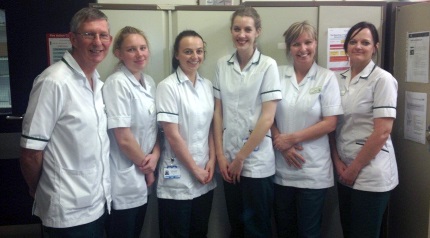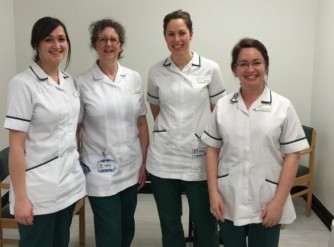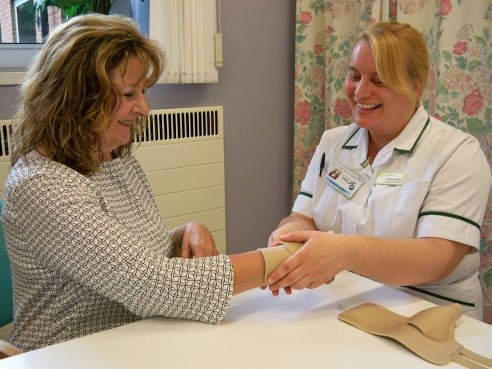

Preparing for your Total Hip Replacement at Chapel Allerton Hospital
Welcome to the elective total hip replacement education session. This DVD will help you prepare for your hip surgery. It is important that you prepare yourself and your home before coming into the hospital to make the best recovery. If you’re watching this DVD at home, you can call the occupational therapy pre-assessment team on the numbers shown. If you have any questions, in order to replace your hip joint, some of the muscles and ligaments that normally provide stability to the joint are cut. These tissues need at least six weeks to heal and become strong again in order for your hip to function well. As a consequence of your hip muscle being weak following your operation, there is a small risk of dislocation.
Hip precautions are recommended during this time to protect your hip while it heals and reduce the risk of the hip dislocating. These precautions are recommended by your surgeon and followed for six weeks. You must avoid crossing your legs at the knee or ankle. Do not bend your hip past 90 degrees. Do not lift your knee above your hip. Do not twist your leg or waist. It is also recommended that you sleep on your back following your surgery; do not use footstools or the recliner action of recliner chairs, and ensure that you rest on your bed for two hours in the afternoon. The leaflet provided will explain your precautions in more detail, so please read this prior to your operation to aid your recovery.
In order to follow hip precautions, you will need to ensure that your furniture at home is at the correct height so that your knee isn’t higher than your hip when you are sitting. This will also promote successful healing following your operation. The precautionary height is the measurement from the back of the knee crease to the floor plus 2 inches. It is easier if someone measures this for you. You should have been sent a furniture Heights form that looks like this.
We require the height of your chair and/or sofa, toilet, and bed to ensure they are suitable and meet your precautionary height following your hip surgery. We will now discuss appropriate furniture and demonstrate the correct way for you to measure it. Your chair should have firm, level arms and a high back. The seat should not slope down at the back. You can sit on a sofa, but a chair is much easier to stand up from as you can push up on both arms, and this is often more comfortable than sitting on a sofa.
To measure your chair, have someone sit on the seat and measure from the lowest point to the floor. If there is nobody available to help you, then push the seat down with your hand to compress it. Measure from the lowest point to the floor. Please measure all the chairs that you sit on at home, such as your dining chair and stair lift seat. If your chair is too low, you can add height with extra cushions or fold up blankets under the seat.
Ask family or friends if they have a suitable chair that you can borrow; alternatively, certain types of chairs can be raised on blocks available from your local equipment store. Measure your bed in the same way: either have someone sit on the bed when measuring or push the mattress down with your hand and measure at the lowest point on the mattress down to the floor. This technique is applicable to all bed sizes. If your bed is too low, you can buy a new mattress, add height with a mattress topper, or add a second mattress to the existing one. Use an alternative bed at home if it is a suitable height. Your local equipment store may be able to raise some types of bed by putting blocks underneath it.
Please be aware that some furniture is not suitable for raising, and this is decided by the equipment store fitters to measure your toilet. First measure from the seat down to the floor, then lift the seat up and measure from the bowl down to the floor. If your toilet is too low, appropriate toileting equipment will be provided by the occupational therapists following your surgery on the ward. Prior to coming in for your surgery, we would advise that you organise your home environment, in particular the kitchen, to ensure that you can get to everything you need with these. You need to think about what items you use regularly and ensure they are within easy reach for you in the kitchen.
rearrange cupboards so the items you use regularly are easily accessible and place commonly used items on the worktop to minimise any need to bend when preparing food or drinks. Always remember to position yourself facing the worktop to avoid twisting. Try to avoid standing for long periods. It can be helpful to have a suitable-height chair to rest on in your kitchen if you have space. If you live alone or anticipate difficulties with cooking after your operation, prepare frozen meals or purchase ready meals.
You may need assistance with both shopping and laundry after your operation. Now is the time to arrange help from friends and family as you walk around your home. Remove any obstacles, ensure any repairs are carried out, e.g., if your stair rail is loose from the wall, and remove any loose rugs as they are a trip hazard. If you have pets, consider how or who will look after them. You may need to consider temporary pet care when feeding your pets. A long-handled dustpan can be used to place the food down onto the floor and lift it back up again. If you do need to bend, then you should study yourself on a sturdy surface, then slide your operated leg behind you while spending your good leg towards the floor. Please refer to your hip replacement booklet, as this will provide you with more information regarding managing your domestic activities at home following your hip replacement. You are advised not to attempt getting into a bath or over-bath shower for 12 weeks, as you will compromise your precautions by attempting this.
You can use a walk-in shower or shower cubicle once you are confident you can stand without your elbow crutches. If you do not have access to a suitable shower, then you will need to strip-wash. You should either stand at the basin or position a suitable height chair at the basin. You should avoid sitting on the edge of the berth to wash in case you slip. Always ensure that you have your toiletries close by to avoid twisting or overreaching for items. And remember, you must not bend down below your knee to wash your feet or cut your toenails. If you do not have anyone who can assist you with this, then it is possible to wash below your knees with a long-handled sponge or a sponge in your easy reach and dry with a towel or hairdryer during your hospital stay.
We encourage you to wear day clothes on the ward; bring comfortable loose-fitting clothes and underwear with you, e.g., tracksuit bottoms and shorts. loose trousers, elastic waist skirts Your feet can swell up after the operation; therefore, we advise loose-fitting supportive Footwear: To accommodate this, we recommend you bring slippers with a BAC or shoes that can be easily taken on and off the day after the operation.
The physiotherapy team will help you to move yourself to the edge of the bed, ensuring you maintain your hip precautions. The physiotherapist will aim to walk you a short distance using a walking frame and sit you out in a chair. The occupational therapy team will assess your washing and dressing to ensure you can manage independently while maintaining your hip precautions. You will require long-handled dressing aids to enable you to do this. If you’re watching this at home, we will arrange provision for your dressing aids. When we speak to you on the telephone, please remember to bring your dressing aids with you when you come in for your operation.
When dressing, sit on an appropriate-height chair or bed. Dress your top half while sitting to conserve energy and maintain your balance. Remain seated to dress your bottom half, removing your footwear with a long-handled shoehorn using the easy reach Gather the leg of your undergarment or trouser and place it over your operated leg. You can then pull this upwards past your knee when you can reach with your hand and feed the second side of the undergarment or trouser leg onto the easy reach. Bring the garment back down to your feet and slip your own operated leg through. Pull the garment up using the easy reach until you reach your knee. Now you are able to stand to adjust your clothing. Remember, do not bend forward. Hold the curved sock in your hand or hold it between your knees.
Loose socks will work best, and a small amount of talcum powder in the sock aid will help your foot slide. Place your socks onto the sock aid and slide it until the sock aid is right to the toe area, the heel of the sock should be to the bottom, and the top of the sock should be concerted into the groove near the strings using the strings. Drop the sock aid to the floor, place your foot into the opening, and walk your foot into the gutter until your toes are right to the end. Pulling the opening wider using the strings will help lift your foot off the floor slightly and pull evenly on the strings to pull the sock onto your foot. Taking socks off is done most easily using your shoehorn or easy reach. Remember the golden rule. Dress your operated leg first and undress it last. Never sit down or stand up with your arms still in the crutches; instead, hold the handgrips in one hand and reach down or push up from the chair with your other hand. The physiotherapist will work with you to progress your walking from using a frame to using elbow crutches and practice going up and down stairs.
Your forearm should sit within the cuff, and the hand grips should face forward when walking. Put the crutches forward together, then step your operated leg up to the crutches. Your non-operated leg then steps up to the crutches, and your operated leg using the crutches allows weight-bearing through your operated leg and helps to gain a correct walking pattern and avoids a limp. The crutches issued to you will be measured to you. Please do not alter them once you are at the bottom of your stairs. If you have a handrail or bannister, take out the crutch at that side and hold it in the opposite direction. Make a t-shape with your crutches and ensure you hold the spare crutch on the outside of your other crutch.
If you did drop the crutch, it would then fall away from your feet. Place your non-operated leg up onto the first step, followed by your operated leg, and lastly, your crutch joins them on the same step. Follow this procedure until you reach the top of the stairs, when you can pass the spare crutch back to the other hand and mobilise as usual to come down the stairs. Reverse the process and hold your spare crutch in the same way. Place your crutch on the step below, then step on to that step with your operated leg.
Lastly, your own operated leg follows onto the same step. Make sure your hand holding on to the handrail or bannister is at the same level as your elbow crutch to reduce any twisting when coming downstairs. Follow this procedure until you reach the bottom of the stairs. The occupational therapist will check that you can safely transfer on and off your chair bed and the toilet whilst you are on the ward and will practice these with you until you are independent.
Any toileting equipment you will need will be assessed for and issued at this time. The expected length of stay following a hip replacement is three days. Some patients recover sooner and are discharged home on day two, while others need longer in the hospital and may require further rehabilitation or support when they go home. You will be discharged home once your wound is healing and you’re able to walk with elbow crutches and manage stairs. If applicable, you are independent in transferring on and off a chair, bed, and toilets. You are able to wash and dress independently.
Any aids or adaptations are in place at home. Please plan your transport home with family or friends. If you are unable to organise your own transport, then please inform ward staff when you come into a hospital you are able to travel in a car as a passenger following your hip replacement. Practice this before the operation. Low-sport cars and people carriers are not advised, as they are more likely to compromise your hip precautions.
Getting into a car, we suggest you park away from the curb, slide the front passenger seat back as far as it will go, recline the seat back, place your back to the car, remove elbow crutches, and sit on the edge of the car seat sideways. Placing a plastic bag on the seat can help you move around more easily. Just remember to remove it before you set off. Slide your bottom back onto the seat. This will help your operated leg over the door sill and into the foot. Be careful not to raise your knee above your hip. At this time, it is important that you leave your leg straight out in front of you for the whole journey.
Remember to remove the plastic bag before you set off and adjust the back of your seat to a more upright position for your comfort during the journey. An information leaflet on car transfers is available. You may drive again approximately six weeks after your surgery, providing an emergency stop is performed without hesitation or discomfort. Test this out while the car is stationary. You are advised to inform your insurance company before returning to driving.
The physiotherapist will now demonstrate your hip exercises, so these are the four exercises that we want to get started with. From now on, you need to do each of them ten times and repeat that three or four times a day once you’ve had your surgery. If Fizzy will be able to advise you on which exercises you should be doing and how often and frequently you should be doing them, so start with these exercises. Hold on to a table or a kitchen worktop.
The first exercise is taking your need pump in front of you, making sure it doesn’t come high, and then your hip and back down. Repeat that 10 times. Exercise number two: stand up nice and tall to pick your leg out to the side and back to the middle nice and slowly and again. Repeat ten times exercise number 3 tip, and you like straight backwards. Make the treat yourself not nice and tall and don’t lean forwards and exercise them before, and then you need to heal up to your mom. Once you have watched this DVD, please contact the department at this number to book a telephone assessment appointment. The occupational therapy pre-assessment team will then assess your needs and answer any questions you may have.
Inpatient services
Our Occupational Therapists (OTs) assess patients’ occupational needs and problem solving when there has been a change to their level of function and independence which can be temporary or long term. OTs facilitate timely and safe discharges, working closely with community agencies to resolve housing requirements, supportive care packages and ongoing rehabilitation and return to employment.
The Occupational Therapists within the Major Trauma Centre (MTC) at Leeds work on the Major Trauma ward and High Dependency Unit. At Chapel Allerton Hospital Orthopaedic Centre (CHOC) the Occupational Therapists provide pre-assessment and ward-based services. Both of these teams deliver care over seven days and all other services are Monday to Friday.
Rheumatology, Major Trauma, Hand and Plastics and Vascular teams provide expert regional services. All other clinical areas provide local services to patients from Leeds.
Outpatient services
Outpatient services are provided as either Occupational Therapy clinics, joint clinics with other services or as part of a consultant clinic.
These include:
- Hand therapy and splinting
- Pressure garments and scar management
- Prosthetics assessment and management
- Rheumatology assessment and treatment
- GP direct access – for patients who have osteoarthritis of their thumb joint

Contact the Occupational Therapy teams
Lucy May – Occupational Therapy Clinical Service Manager – 0113 3927294 (LGI)
- Trauma and Orthopaedics LGI – Tel: 0113 3927294
- Major Trauma Centre, Vascular, Cardiology and CDU at LGI – Tel: 0113 3927194
- Rheumatology Chapel Allerton – Tel: 0113 3924528
- Elective Orthopaedics Chapel Allerton – Tel: 0113 3924842
- Pre-assessment at Chapel Allerton – Tel: 0113 3924525